Is your family safe from electrocution?
Switchboard Safety
Each year Australians are killed in homes where electrical accidents could have been prevented. Even more are hospitalised with serious electrical injuries and burns. Many of these could have been prevented if safety switches had been installed in their house.
Preventable accidents with tragic consequences:
- a child inserting an implement into a toaster
- a handyman drilling into a live cable inside a wall
- stormwater leaking through a roof and into lights and appliances
Avoid tragedy and have a safety switch installed in your home
Master Electricians Australia is committed to helping home owners stay safe. A 10-point visual safety check of your home’s switchboard is now available. Unsafe switchboards can lead to fire, electric shock and potentially death. Your Master Electrician will discuss with you any electrical safety issues requiring urgent attention and things you might like to consider for the future.
If you have engaged a Master Electrician to undertake work for you, the 10-point visual safety check can be completed whilst on-site, no additional cost. If you require an electrician to come to your home to only undertake the safety check there will be a charge. Your electrician will discuss this with you prior to attending your home.
From January 2019, safety switches became mandatory on all circuits in new homes. They are designed to cut the power to an electrical circuit in the event of an electric shock. Safety switches on all circuits in the switchboard will increase the overall safety of the home.
Safety switches on all circuits in your switchboard save lives
-
What’s the difference between a safety switch and circuit breaker?
A safety switch protects people from electric shock, a circuit breaker only protects electrical cables and appliances when they are faulty or abused.
-
How does a safety switch work?
Electricity flows from your switchboard to an appliance and back to the switchboard.
If the wire gets damaged, this can result in the electricity leaking to the appliance or any person touching it.
In this case not all the electricity returns to the switchboard, instead it will flow through the body of the person in contact with the circuit.
This can result in muscle spasms including ventriculus vibration or disruption of the heart muscles.
A safety switch will detect the leakage and will trip the circuit within as little as 30 milliseconds. This stops the flow of electricity through the body of the person and significantly reduces the risk of death or serious injury.
-
How do I know if I have a safety switch on all circuits in my switchboard?
Safety switches have a ‘test’ button on the front face
If the devices on a domestic switchboard do not have a ‘test’ function, they are likely to be circuit breakers rather than safety switches.
The test button should be used several times each year to test that the safety switch is still functioning.
-
I do have one safety switch; am I protected?
As a result of regulation and public awareness campaigns, around 65 per cent of Australian homes have at least one safety switch.
Around half this number of homes has safety switches on the lighting circuits as well as on the power circuits.
However, while this is a good start, it does not provide total protection. The circuits that supply appliances such as ovens, stoves, hot water systems and air-conditions remain unprotected in most Australian homes.
A range of factors such as water ingress, screwing or nailing through live cables inside walls, and contact with damaged equipment can cause injury or death on circuits other than power and lighting.
To achieve the highest level of protection for home occupants and tradespeople, every circuit in the home should be protected by a safety switch.
As of the 1st of January 2019, all new homes being constructed must have all their circuits protected by safety switches.
Types of home safety switches
-
Switchboard-mounted safety switches
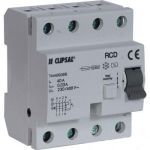 This type of safety switch is the device required by law to be fitted to homes.
This type of safety switch is the device required by law to be fitted to homes.They are located alongside circuit-breakers in the home’s switchboard and can be distinguished from circuit breakers by the presence of a button marked “test”, which is located on the front face of the device.
-
Combination safety switch and circuit breakers in switchboards
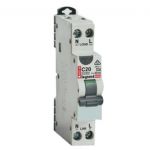 Some homes have a combined circuit breaker and safety switch installed on their circuits.
Some homes have a combined circuit breaker and safety switch installed on their circuits.These devices protect the electrical circuits and appliances attached to them, but also offer the safeguards against electrical injury and death that can only be achieved with a safety switch.
These devices if installed at the time of construction do not require any additional labour than a standard circuit breaker.
-
Other types of safety switches
 In older homes or in specific environments such as workshops or bathrooms, safety switches may be manufactured as a combination safety switch powerpoint.
In older homes or in specific environments such as workshops or bathrooms, safety switches may be manufactured as a combination safety switch powerpoint.Again, this type of safety switch can be distinguished by the test button on its front face.
Example of completed Switchboard Safety Check
Recently, we had a member complete a 10-Point Switchboard Safety Check on a customer. The results are as follows.
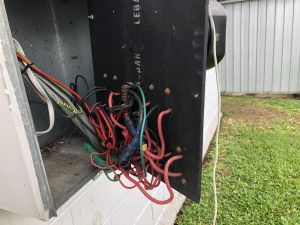
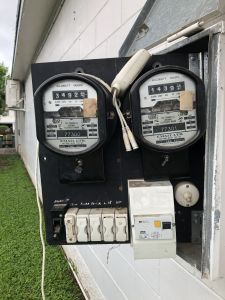
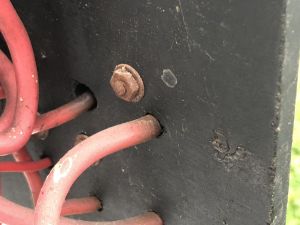
(left – Vermin and Asbestos, centre – Rewireable fuses, right – Hot joints)
Score: 5/10
The installation failed on the following areas:
- Point 2 – Switchboard is free of vermin – evidence of vermin activity and cable entry hole unsealed.
- Point 3 – No asbestos visible – Metering panel made of Lebah.
- Point 4 – Main Earth in sound condition – No main earth stake only connection water pipe lead in (copper) appropriate to standard of the day. MEN connection intact and in good condition.
- Point 5 – No rewireable fuses – Original installation circuits still protected by fuses. Stove, Light, 2*Power & Hot water.
- Point 8 – Safety Switches – other circuits. RCD protection not on Stove, Hot Water and 1 * Air/Con.
Important notes:
- Urgent Action – Hot joints observed on line side of Main Switch and Stove fuse.
- Other Action – Recommended switchboard upgrade to address items above.
Click Here to download 10-Point Switchboard Safety Check
Terms and Conditions
This Safety Check has only involved a visual inspection of the equipment referred to on this document as it was at the time of inspection. Your Master Electrician cannot be held liable for any change in condition of that equipment, any loss or damage, including for consequential loss, arising from any defect or condition not noted on this document as seen by the Master Electrician nor for any failure to inspect, identify or advise you of any defect or failure other than those specifically noted on this document including liability arising from inaccessibility, oversight or negligence. This Safety Check is provided for your personal use only and may not be provided to any third party and any liability to any third party to whom it is provided, is specifically excluded including for negligence.